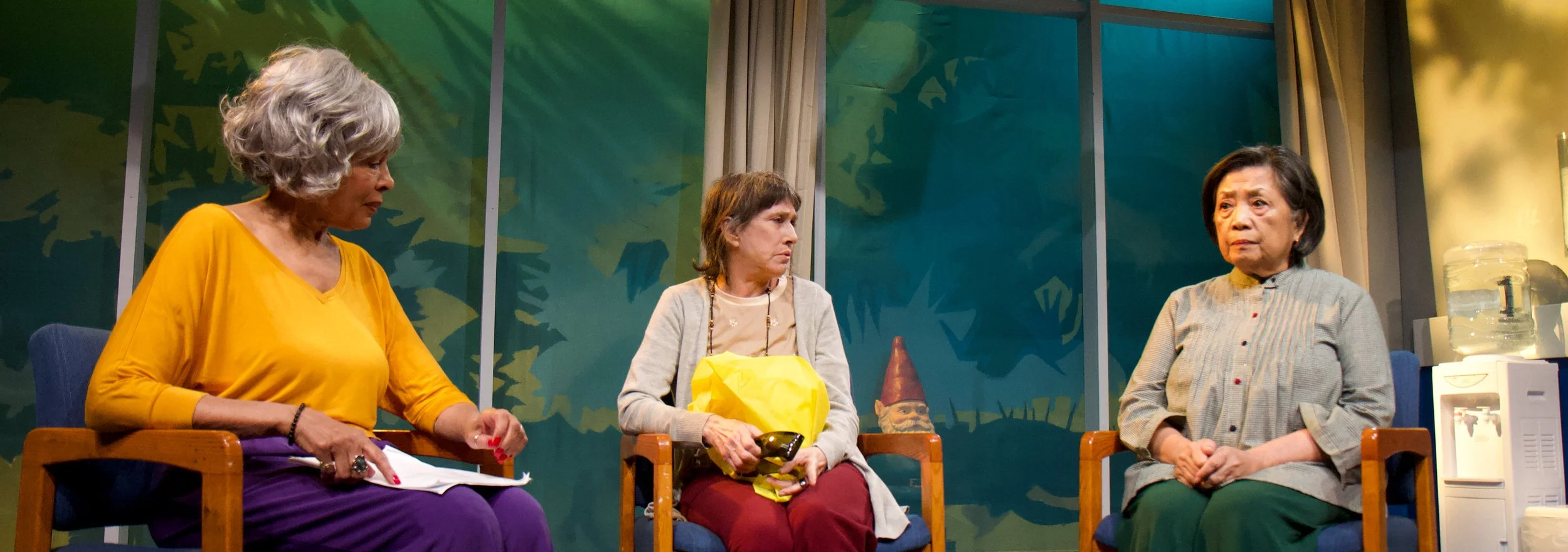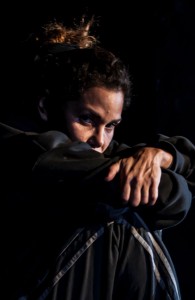Solo: A Show about Friendship is comedian Gabe Mollica’s dramatization of wild fluctuations in his luck with friendship and sex. It’s an hour-long backward glance, from growing up on Long Island to the present, triggered by a milestone birthday: “I turned 30,” Mollica tells the audience, “and realized I had no friends.”
Cheers!
The illusory brand of theatrical magic is difficult to find—especially in solo shows. Precious few one-man productions can effectively create that beautiful “baseless fabric” of a transportive play, and even then, their illusions are sometimes imperfect. A single body moves across a deserted stage with not much else but light and music and those elemental players for company. It’s easy to falter when carrying the weight of performance alone, but writer/comedian Terri Girvin, the multi-character star of director Michael Leeds' production of Last Call at the IRT Theater, bolsters an otherwise ordinary tale of a long-serving New York bartender with surprising humor and extraordinary moments of intimacy.
Pools of soft, yellowing light accompany Terri Girvin as she moves through her life story. She begins with a series of easy jokes; "Top 10 Ways to Annoy Your Bartender" is a recurring and sometimes quite delightful theme that runs through her monologues. She then proceeds to insert details of her family’s dysfunctional history in momentary, painful snapshots. These scenes are relayed with grim amusement on Girvin’s part, as it is her mother, a divorced, drink-happy ex-party clown who is the source of this dysfunction. Here, Girvin’s practiced, punch-line-delivering style gives way to the emotional drama of her relationship with her mother. Halfway through the play, the audience becomes unsure of its laughs, and seem more comfortable in silence.
But the scenes themselves are transitory. They seem more like floating motes of experiential anecdotes rather than seamless parts of an organic autobiography. Here is where Girvin’s talent for stand-up comedy interferes slightly with theatrical storytelling. The moments in which Girvin’s mother steps onto the stage in the guise of her own daughter are short; Girvin impersonates her mother uneasily, and is keen to relieve her audience’s tension with a joke. It’s easy for the audience to see that Girvin’s mother is an emotionally dependent, paranoid, unstable and completely unfit parent, but somehow her daughter doesn’t realize that this legacy is in her hands until the end. Consequently, Girvin’s mother, only heard and not seen, is never fully redeemed. For most of the production, she is a two-dimensional weight on her daughter’s shoulders. Girvin, by her own reckoning, deeply desires “freedom from the weight of her [mother’s] trauma.”
Regardless of these dips in storytelling, it is apparent that Girvin is the only person from her family who can stand her mother’s antics. She also seems, by her own telling, to be more involved in her mother’s disorganized life than her largely indifferent brothers. Girvin’s brother is especially blunt: “It’s fun when the circus comes to town, but when the circus never leaves!” A particularly hectic night at the bar sees Girvin taking close to 50 orders every 10 minutes. It is perhaps the aural and visual climax of the entire production. Girvin’s silent co-stars put on terrific performances, as evidenced by the unique collaboration between Grammy-nominated sound designer Phil Palazzolo and lighting designer Jason Fok.
With not a single prop in sight, Girvin clinks imaginary shot glasses onto the bar and pours fizzing drafts of beer into empty steins. She chats genially with the disembodied voices of her customers and slams a nonexistent cash register closed before turning to the audience and grinningly inquiring, “What can I getcha?” Every delectable sound, from the dull roar of conversation to the sloshing of a drink, matches in near-perfect synchronicity with Girvin’s expert movements. Every voice has its own extraordinarily ordinary life; Palazzolo and Fok have squeezed alchemical gold from the listless air with their superb intertwining of light and sound.
But the harmony of Girvin’s movements, in perfect beat and cadence to the swing of her bar, quickly devolves into chaos when she receives a call from her mother. Without revealing Girvin’s mother’s shocking escapade, and the proverbial last straw for Girvin herself, the harried and exhausted bartender ends up kicking everyone out of her bar. She listens shamefacedly to her customer’s insults and drunken raging (who only minutes before had flirted, smiled or laughed with her). She then slams her phone onto the bar, looking out teary-eyed and tired at her arrested audience as we wonder: Was that their last call?
It is this explosive scene that discloses the fundamental problem Girvin has with marrying the architecture of her life to that of her mother. We are never sure if she takes up the Sisyphean task of maintaining any semblance of a relationship with her mother after this. But this unmarried, diminutive, middle-aged working woman is still a hopeful, optimistic child at heart. Her ever-cheerful retort to the dull greeting, “How are you?” is a loud, “Living the dream!” The final scene is nostalgically beautiful, and we stitch up her disparate stories of love, loss and emotional pain into a safe blanket we wish we could cover her in. And in perhaps the most moving, and most fitting, end to this darkly humorous tale of a life not yet fully lived, Girvin leaves us with no ending. We only have her memories.
Last Call ran from Oct. 9-Nov. 1 at the IRT Theater (154 Christopher St., #3B) in Manhattan. For more information, visit www.terranovacollective.org.
Down in the Depths
Solo shows tend to be showcases for talented actors, but the shows themselves may be variable. Sometimes they are mere vehicles for a talented star; sometimes they are more than vehicles. And once in a while, as in Empanada Loca, with Rent alumna Daphne Rubin-Vega, the star provides jet fuel for the vehicle. Playing a woman named Dolores in Aaron Mark’s precisely calibrated, terrific script, Rubin-Vega demonstrates that she is, even without singing, an astonishing talent.
As the show opens, Dolores spots the audience and wonders how we managed to find her. She’s in a deep disused subway tunnel in the New York system. She’s hiding out, and around her, in Bradley King’s astonishingly dim but effective lighting, one can barely make out a grate on the upstage wall and a large massage table. She is not used to visitors, although she says, “They still come down, sometimes they come, when they're expanding. They like this tunnel ’cause I got electricity—I set these lights up myself—and I got privacy, ’cause this is as far down as you can go. This is one of those tunnels the city gave up on before they even laid the tracks.”
No longer apprehensive, soon she is unspooling her life story, and Rubin-Vega brings warmth and passion to a tale that involves hard knocks and gruesome twists. “I’m only down here ’cause I'm not goin’ back to prison,” she says. “Thirteen years, they locked my ass up.”
She started out an ordinary college kid, a student at Hunter. “I was gonna be a urban planner,” she recalls. But her Aussie roommate wanted weed one day, and Dolores went along and met Dominic, a drug dealer. At the same time, her mother died and her father, a doorman, went to pieces and couldn’t take care of her. So she moved in with Dominic, whom she protected from prison after the police picked her up. After coming out, she went looking for Dominic and the money they’d stashed, and both were gone. The old neighborhood had one or two familiar faces, but nobody knew where Dominic was. But she spots a favorite haunt, Empanada Loca, which makes the small pies that are central to Latin cuisine. Inside is Luis, son of the proprietor she once knew; she knew Luis, too, but he was a child and is now a young man. He gives Dolores his late father’s room and even helps her drum up business by putting a sign in his window for her massage business. It’s a skill she learned in prison from her lesbian protectress, Tabitha.
Mark, who also directs lovingly, provides ample humor. Describing Dominic, Dolores remarks that she noticed he had “fingers like sausages” and bawdily suggests what one might extrapolate from that. The script is vivid, evocative and specific. There are mentions of a “purple hat,” a “red glass bong,” and at a Planet Fitness gym in the neighborhood, “these white chicks in polo shirts working there, they’re making green smoothies or some shit.” Dolores momentarily forgets what her father choked to death on, then remembers: “shish kabob.”
Eventually complications arise between Dolores and Luis, and the story grows darker. There’s a tip-off in the program about the inspiration for Mark’s show, but it’s better if you haven’t read it. There’ll come a point when the savvy theatergoer will suddenly cotton to the source—it’s been used in a famous musical—but Mark has gone back to original publications of the story and made enough alterations in place and character that it takes a major plot point to turn the audience member in the right direction. Suffice it to say, it’s a dark place that Dolores and Luis end up in.
Clad only in a black hoodie and black slacks, Rubin-Vega is a terrific guide to this hellish underworld, colored simply and darkly by David Meyer in shades of charcoal. When the story turns cringe-worthy, she is still a commanding presence. It’s not just a good performance; it feels like a landmark for a consummately gifted actress.
The solo show Empanada Loca plays through Nov. 8 at the Labyrinth Theater Company (155 Bank St. between Washington St. and the West Side Highway) in Manhattan. Evening performances are at 7 p.m. on Oct. 25 and 26, and Nov. 1, 3 and 8. They are at 8 p.m. on Oct. 28–31 and Nov. 4–7. For tickets, visit labtheater.org.










